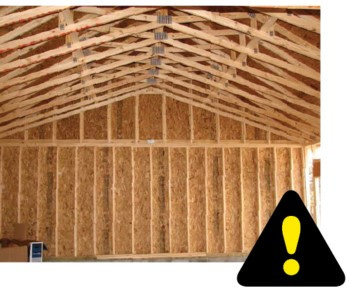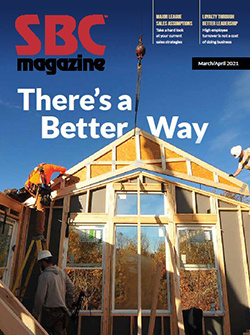There's a Better Way
There's a Better Way

Providing a flat-bottom, gable-end roof frame for framers to install on an end wall is a traditional best practice for truss systems that have a corresponding bottom chord profile. Conversely, when the roof truss system has a sloped bottom chord, like in the case of scissor trusses, installing a flat-bottom, gable end frame is a discouraged practice (see at right). For component manufacturer (CM) designers, it’s important to understand why and consider some best practice alternatives.
End Wall Performance
The building code (see below) requires wall studs to be continuous from the sole plate of a wall up to the ceiling or roof diaphragm. When the end wall has a top plate level with
the other exterior walls, there is no ceiling diaphragm at the intersection of the wall and a flat-bottomed gable end frame because the ceiling diaphragm is created by the sloped truss system.
The consequence of this approach is that the lack of lateral resistance creates a hinge where the end wall top plate meets the flat bottom chord of the gable end frame (see Figure 1). This hinge provides very little structural resistance to any horizontal pressure or lateral loading applied during inclement weather. While in extreme cases this may lead to a wall collapse, it can be very common for drywall cracking to occur, prompting costly customer callbacks and repairs.
Chapter 23, Section 2308.5.1 of the IBC 2018:
Size, height and spacing. The size, height and spacing of studs shall be in accordance with Table 2308.5.1 except that utility-grade studs shall not be spaced more than 16 inches (406mm) o.c., or support more than a roof and ceiling, or exceed 8 feet (2438 mm) in height for exterior walls and load-bearing walls or 10 feet (3048 mm) for interior non load-bearing walls. Studs shall be continuous from a support at the sole plate to a support at the top plate to resist loads perpendicular to the wall. The support shall be a foundation or floor, ceiling or roof diaphragm or shall be designed in accordance with accepted engineering practice.
Chapter 6, Section R602.3 of the IRC2018:
Studs shall be continuous from support at the sole plate to a support at the top plate to resist loads perpendicular to the wall. The support shall be a foundation or floor, ceiling or roof diaphragm or shall be designed in accordance with accepted engineering practice.
Best Practice Alternatives
Fortunately, BCSI provides two best practices a CM can implement. One is calling out a balloon-framed gable end wall (see Figure 2). Chris Tatge, owner of Dynamic Construction and current president of the National Framers Council (NFC) says, “a wall with an angled top plate like that would typically be laid out and built on the ground and then lifted into place. While structurally correct, the drawback to this approach is that it’s incredibly time consuming to accomplish in the field. Further, it can’t be left to front-line framers, it requires someone with a lot of framing experience to build.”
The other best practice, and one framers like Chris would prefer, is for the CM to provide a gable end frame that exactly matches the profile of the roof truss profile (see Figure 3,
which shows a scissor gable end frame along with a ballooned gable end wall). “When the CM provides that gable end frame, it makes the framer’s job a lot easier,” says Chris. “While the framer will still lay the angled top plate wall out on the ground, the measurements become a lot easier. One, the framer doesn’t have to worry about perfectly matching up the exterior roof plane where the roof sheathing is applied, it’s really difficult to recover from a mistake like that. Two, the framer also has the ceiling profile provided, making all the measurements easier.” Meaning it takes less time and less skill to install correctly on the jobsite.
Jason Langreck, P.E., an engineer for Automated Products, says they started providing sloped bottom chord end frames to their framers about seven years ago. “We note along the end wall that it should be balloon framed to the bottom side of the gable end frame,” says Jason. He stresses it is important to engage the framer (and potentially the building inspector) in advance if you are implementing this approach for the first time. Education will help avoid a situation where the framer builds the end wall with a top plate matching the rest of the exterior walls, installs the sloped bottom chord gable end frame and then fills in the resulting gap with additional framing (see Figure 4). “That ends up creating the same problem of a hinge at the wall top plate,” says Jason.
Our Industry Is Stronger When It Is United
With that goal in mind, the leadership of SBCA and TPI are committed to relying more on each other’s strengths and working together to create solutions that propel the entire industry forward. This article is the result of a collaboration between the members of the Truss Plate Institute’s Technical Advisory Committee (TPITAC) and SBCA. It kickstarts a technical article series driven by TPITAC members that seeks to address pertinent engineering topics and provide design best practices.
Bottom Line
When supplying sloped bottom chord roof truss systems, CMs should strongly consider providing a gable end frame with a matching profile and specify a balloon wall framed to its bottom side. This approach will not only avoid producing a hinge joint in the end wall, which may lead to performance issues, it will provide a framer-friendly solution in the field.






